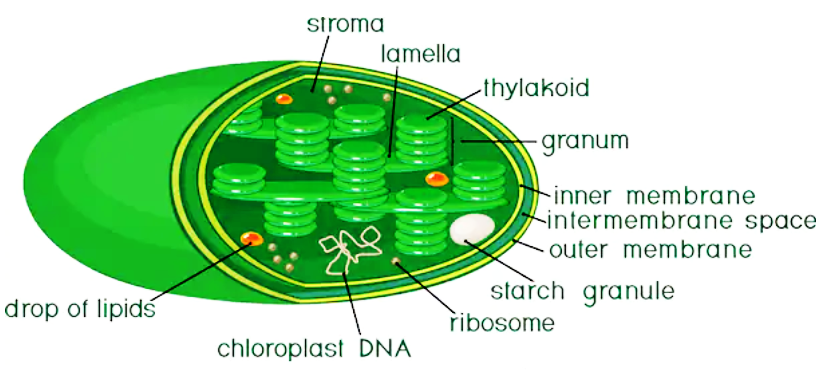
Explain the structure of a chloroplast with the help of a rough diagram.
Answer
574.2k+ views
Hint: Chloroplasts are green coloured plastids which function as the site of photosynthesis in eukaryotic photoautotrophs. They are mostly found in the cells of the mesophyll in plant leaves along their walls for easy diffusion of gases and receiving optimum quantity of incident light.
Complete answer:
The chloroplast is a structure which is surrounded by two unit membranes of 9-10 mm of thickness. They are separated from one another by a space called periplast ideal space. Internally there are two distinct regions of a chloroplast known as the grana and stroma. Grana are made up of aggregation of disc-shaped structures known as thylakoids. The grana of the chloroplast consist of chlorophyll pigments and are the sites for the light reactions. Stroma or matrix is the homogenous matrix which comprises grana and is similar to the cytoplasm in cells in which all the cell organelles are embedded. Stroma also contains various enzymes, DNA, RNA, ribosomes, and other substances. Stroma lamellae helps in connecting the stacks of thylakoid sacs.
The chloroplast structure consists of the following parts that are as follows:
> Membrane Envelope
It comprises inner and outer lipid bilayer membranes. The inner membrane divides the stroma from the intermembrane space. It is a semi-porous membrane which means it is permeable to small molecules and ions, that diffuses easily. The outer membrane of the chloroplast envelope is not permeable to larger proteins.
> Intermembrane Space
It is usually a thin inner-membrane space about 10-20 nm and it is located between the outer and the inner membrane of the chloroplast.
> Stroma
Stroma is an alkaline, colourless, aqueous, protein-rich fluid which is present within the inner membrane of the chloroplast.
> Thylakoid System
This system is suspended in the stroma. It is an aggregation of membranous sacs called thylakoids. Chlorophyll, the green coloured pigments are found in the thylakoid membranes. It is the sight for the light-dependent reactions of the photosynthesis. The thylakoids are arranged to form stacks of discs known as grana and each granum contains around 10-20 thylakoids.

> Chlorophyll
It is a green coloured photosynthetic pigment that assists in the process of photosynthesis.
Note: Chloroplasts are considered as the site of photosynthesis in eukaryotic cells. They are chiefly found only in photosynthetic cells like plant cells and algae. No chloroplasts are found in animal or bacterial cells.
Complete answer:
The chloroplast is a structure which is surrounded by two unit membranes of 9-10 mm of thickness. They are separated from one another by a space called periplast ideal space. Internally there are two distinct regions of a chloroplast known as the grana and stroma. Grana are made up of aggregation of disc-shaped structures known as thylakoids. The grana of the chloroplast consist of chlorophyll pigments and are the sites for the light reactions. Stroma or matrix is the homogenous matrix which comprises grana and is similar to the cytoplasm in cells in which all the cell organelles are embedded. Stroma also contains various enzymes, DNA, RNA, ribosomes, and other substances. Stroma lamellae helps in connecting the stacks of thylakoid sacs.
The chloroplast structure consists of the following parts that are as follows:
> Membrane Envelope
It comprises inner and outer lipid bilayer membranes. The inner membrane divides the stroma from the intermembrane space. It is a semi-porous membrane which means it is permeable to small molecules and ions, that diffuses easily. The outer membrane of the chloroplast envelope is not permeable to larger proteins.
> Intermembrane Space
It is usually a thin inner-membrane space about 10-20 nm and it is located between the outer and the inner membrane of the chloroplast.
> Stroma
Stroma is an alkaline, colourless, aqueous, protein-rich fluid which is present within the inner membrane of the chloroplast.
> Thylakoid System
This system is suspended in the stroma. It is an aggregation of membranous sacs called thylakoids. Chlorophyll, the green coloured pigments are found in the thylakoid membranes. It is the sight for the light-dependent reactions of the photosynthesis. The thylakoids are arranged to form stacks of discs known as grana and each granum contains around 10-20 thylakoids.

> Chlorophyll
It is a green coloured photosynthetic pigment that assists in the process of photosynthesis.
Note: Chloroplasts are considered as the site of photosynthesis in eukaryotic cells. They are chiefly found only in photosynthetic cells like plant cells and algae. No chloroplasts are found in animal or bacterial cells.
Recently Updated Pages
Why are manures considered better than fertilizers class 11 biology CBSE

Find the coordinates of the midpoint of the line segment class 11 maths CBSE

Distinguish between static friction limiting friction class 11 physics CBSE

The Chairman of the constituent Assembly was A Jawaharlal class 11 social science CBSE

The first National Commission on Labour NCL submitted class 11 social science CBSE

Number of all subshell of n + l 7 is A 4 B 5 C 6 D class 11 chemistry CBSE

Trending doubts
What is meant by exothermic and endothermic reactions class 11 chemistry CBSE

10 examples of friction in our daily life

One Metric ton is equal to kg A 10000 B 1000 C 100 class 11 physics CBSE

1 Quintal is equal to a 110 kg b 10 kg c 100kg d 1000 class 11 physics CBSE

Difference Between Prokaryotic Cells and Eukaryotic Cells

What are Quantum numbers Explain the quantum number class 11 chemistry CBSE




